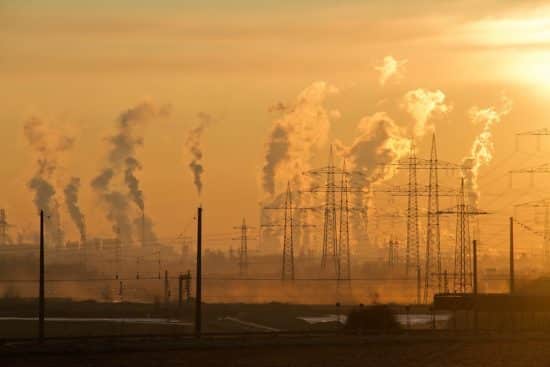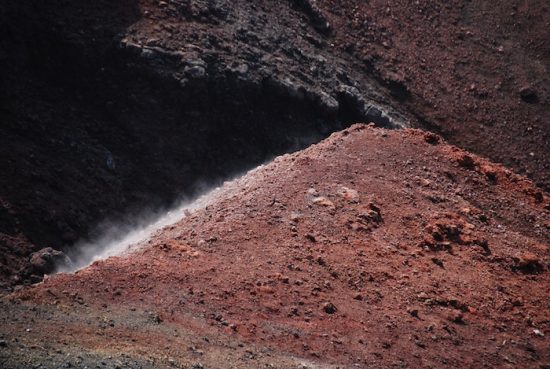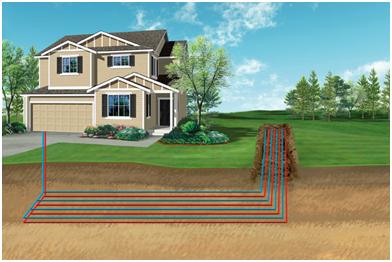Geothermal heating and cooling, which takes energy from the heat stored in the Earth, gives households and businesses and opportunity to reduce their carbon footprint by taking clean renewable energy from the ground and transferring it through pumps into a property. It is one of the popular trending ways to combat climate change.
Jump To Page Contents

- Climate Change Update
- Choosing New Energy Options
- Video Explaining Geothermal Energy
- What Is Geothermal Energy?
- Environmental Impacts of Geothermal Heating & Cooling
- Financial Benefits of Geothermal Heating & Cooling
- How Geothermal Energy Works
- How Geothermal Heat Pumps Work
- How Geothermal Loops Work
- Your Next Steps To Make a Climate Impact
What’s Happening With Climate Change Trends?

The Federal government’s release of the 2018 National Climate Assessment (NCA) delivered a strong message about the continued warming of our planet and how that impacts more than just our fragile environment. The report concluded that “climate change is expected to cause growing losses to American infrastructure and property and impede the rate of economic growth over this century.”1
Poland’s Katowice Climate Change Conference that took place in early December 2018 had a simple but candid theme for all participants: Take Climate Action.2 During a time when the US government’s current administration is moving away from the 2015 Paris Agreement, it is the private companies and individual American citizens who are now taking those climate actions into their own hands.
Take Climate Action: Choosing New Energy Options
The call to “take climate action” leads to an obvious question: What can I actually do? Burning fossil fuels like coal, natural gas or propane are what we are used to. These are the popular, historical options energy companies continue to deliver. These systems keep our homes warm in the winter and cool in the summer. And they work. They seem reliable.
But we cannot sustain fossil fuel use and keep our planet healthy for the emerging generation. It is that resounding scientific consensus and reality check that leads to the most concrete climate action we can take in our homes and offices: choosing a sustainable, renewable energy source to warm and cool our homes and workspaces.
Heating and Cooling Homes – Moving Beyond Fossil Fuels
Our living spaces and the people (and pets!) that dwell in them require temperature regulation. According to research and reporting from the U.S. Environmental Protection Agency (EPA), approximately 42 percent of energy use in U.S. residences and about 36 percent of energy use in U.S. commercial buildings goes to space heating.3 Most of that heating and cooling comes through burning fossil fuels like coal, natural gas, oil, and propane. The demand for heating and cooling will not go away, but the delivery method of those needs is where we can begin a shift in focus to consider effective emerging technologies.
Enter geothermal energy.
What is Geothermal Heating and Cooling?
Geothermal heating and cooling is when you take the energy out of the ground and use that to heat and cool your home. Since geothermal uses energy that is in the earth, that energy is free, it doesn’t pollute, and it’s renewable. Geothermal can very effectively heat the air and water in your home or business property.
The benefits of geothermal energy as a supplement or replacement for fossil fuels can fall into two categories:
- Save the Planet
- Save your Pocketbook
Whatever the motivator, consumers come out ahead in both scenarios when making the switch. Let’s take a look at both.
Environmental Impacts of Geothermal Heating & Cooling
An interview with Geothermal Energy Expert, Jay Egg, revealed the following facts about geothermal heating and cooling:
- Is Geothermal renewable? Geothermal heating and cooling is renewable; a heat pump is used to pump abundant solar-thermal energy from the Earth in the winter time, and back into the Earth in the summertime.
- Why is geothermal energy considered a renewable resource? Because the shallow Earth is functionally a solar thermal battery, and the Sun recharges this earth-battery daily and seasonally.
- How does geothermal energy affect the environment? Since geothermal heat pumps use electricity (not combustion of fossil fuels), they have no on-site carbon emissions. As a result, geothermal sourced heat pumps have the lowest carbon footprint of any heating and cooling system available.”
So how Does Geothermal Energy Affect the Environment?
Here are some points to consider about geothermal energy and the planet:
- According to the EPA, replacing an ordinary HVAC system with geothermal is the environmental equivalent of planting 750 trees
- Geothermal systems produce no on-site emissions
- According to the EPA, geothermal systems are the most energy efficient, environmentally friendly, and cost-effective comfort systems available
- Geothermal units are stored indoors, so there are no outdoor units creating heat and noise. They are also protected from the elements
- Geothermal units have no chemical by-products, therefore greatly reducing the risk of carbon monoxide poisoning in your home or gas leaks
- Every 100,000 homes with geothermal heat pump systems reduce electricity consumption by 799 million kilowatt hours annually
Financial Benefits of Geothermal Heating & Cooling

We are all motivated by money. The financial gains for geothermal energy are compelling:
- The U.S. General Accounting Office estimates that if geothermal systems were installed nationwide, they could save several billion dollars annually in energy costs and substantially reduce pollution
- Tax credits along with a number of rebate programs exist in many states for geothermal ground source heat pump installation
- Geothermal systems represent a savings to homeowners of 30 to 70 percent in the heating mode and 20 to 50 percent in the cooling mode, compared to conventional systems
- Geothermal heat pumps strengthen U.S. energy security. For every 100,000 homes using geothermal HVAC, the U.S. reduces its foreign oil consumption by 2.15 million barrels a year
- Schools using geothermal systems in the U.S. are saving a combined $25 million dollars a year in energy expenses and are putting those funds into better equipment, books, computers, and more teachers
The evidence of human-caused climate change is overwhelming and continues to strengthen, that the impacts of climate change are intensifying across the country, and that climate-related threats to Americans’ physical, social, and economic well-being are rising.” – Fourth National Climate Assessment 4
How Does Geothermal Heating and Cooling Work?

The trend for using geothermal heating and cooling has now surpassed one million homes across the American landscape. The goal of these households: replace the use of fossil fuel energy sources with technologies that get the job done, reduce the carbon footprint and make climate action a tangible and practical reality.
Here’s how geothermal heating and cooling works: The temperature in any given location fluctuates with the changing seasons. The ground temperature four to six feet below the ground surface remains fairly constant all year long. The Earth absorbs approximately 40 – 60 percent of the heat from the sun. That makes the earth one giant solar panel. The key to geothermal systems is getting that energy out of the ground and putting it into your home or business property. That is achieved through the use of a heat pump connected to a series of buried pipes, commonly referred to as geothermal loops.
A geothermal heating and cooling company usually installs polyethylene pipes or loops underground by digging wells. These pipes are filled with a water solution and sealed using heat fusion. It’s that water solution that does the work of the heating and cooling transfer between ground and property. In a typical geothermal system you’ll drill four 200-foot wells, tie them together, extract that heat out of the ground and bring it into the property which houses your geothermal heat pump.
How Does a Geothermal Ground Source Heat Pump Work?
When the goal is heating without fossil fuels – a geothermal heat pump will circulate the water solution which takes heat from the ground and deliver it to a building. From there it can be distributed to heat the air or water. When the goal is cooling, it works in reverse. Much like a traditional air conditioning unit, the heat pump will remove heat from the building and transfer it not to the outside air, but back to the ground, where it will get heated again and become available to repeat the cycle. This process is often referred to as a geothermal exchange. And that’s what makes the energy a renewable resource, taking 75% of the energy needed out of the ground.
How Do Geothermal Loops Work?
There are several ways to install a geothermal energy system onto a property. The most popular methods include:
- Vertical Loops
- Horizontal Loops
- Lakes
- Wells
The loop refers to the moving of energy from your warm house, into the ground, and back into the house, all according to which season you need the heating and cooling. Read more:How Geothermal Loops Work.
Take the First Steps Toward Geothermal Heating & Cooling
Climate change continues to be the 21st-century challenge heaped upon all of us. Fossil fuels cannot be sustained indefinitely and the time to take climate action is now. Geothermal energy offers a genuinely positive climate impact, creates a win for consumers and moves in a direction that reduces the carbon footprint one household and business at a time.
If you’re ready to answer the call to take climate action and actually achieve steps toward a safer and better tomorrow for this vulnerable planet we all share, reach out to an energy expert near you. An experienced and licensed geothermal heating and cooling company will be able to evaluate your property and help you choose your strongest and most beneficial energy option for both your bankroll and our the Earth. We at Hoffmann Brothers are always willing to take your phone call and answer your geothermal questions. Give us call today at 314-664-3011 or request more information here.
1. [https://nca2018.globalchange.gov/]↩
2. [https://unfccc.int/achieving-the-sustainable-development-goals-through-climate-action]↩
3. [https://19january2017snapshot.epa.gov/rhc/renewable-space-heating_.html]↩
4. [https://nca2018.globalchange.gov/]↩
Other Helpful Resources from Hoffmann Brothers
- Carbon Monoxide in Home – Find Solutions
- Air Conditioner Not Cooling – Troubleshooting Guide
- How to Unclog a Sink, Bathtub or Shower
- Electrical Outlets Safety Checklist
- Eliminating a Sewer Smell in Bathroom and Throughout the House
- Replace a Stab Lok Breaker in your Federal Pacific Electric Panel




